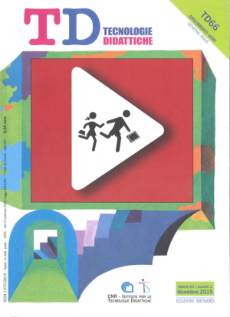Disability, play and robotics in kindergartens
Main Article Content
Abstract
Article Details
Authors who publish with this journal agree to the following terms:
- Authors retain copyright and grant the journal right of first publication with the work simultaneously licensed under a Creative Commons CC BY 4.0 Attribution 4.0 International License.
- Authors are able to enter into separate, additional contractual arrangements for the non-exclusive distribution of the journal's published version of the work (e.g., post it to an institutional repository or publish it in a book), with an acknowledgement of its initial publication in this journal.
- Authors are permitted and encouraged to post their work online (e.g., in institutional repositories or on their website) prior to and during the submission process, as it can lead to productive exchanges, as well as earlier and greater citation of published work (See The Effect of Open Access)
References
Ackermann, E. (2001). Constructivisme et constructionnisme: quelle difference. In Proceedings of the Conference “Constructivismes: usages et perspectives en education”: Vol.1 (pp. 85-97).
Ackermann, E. (2002). Ambienti di gioco programmabili: cos’è possibile per un bambino di quattro anni. TD-Tecnologie Didattiche, 10(3), 48-55. Retrieved from http://www.tdjournal.itd.cnr.it/files/pdfarti cles/PDF27/Ambienti.pdf
Alvarez, L., Rios, A.M., Adams, K., Encarnação, P., & Cook, A.M. (2013). From infancy to early childhood: the role of augmentative manipulation robotic tools in Cognitive and Social Development for Children with Motor Disabilities. In J.L Pons, D. Torricelli, M. Pajaro (Eds.), Converging Clinical and Engineering Research on Neurorehabilitation Biosystems & Biorobotics, (pp. 905-909). Retrieved from http://link.springer.com /content/pdf/10.1007%2F978-3-642- 34546-3 _147.pdf
Bateson, G. (1956). The message,”This is play”. Group Processes, 2, 145-241.
Battegazzorre, P. (2009). Bee-bot, fare robotica con un giocattolo programmabile a banalità limitata. Atti Didamatica. Retrieved from http://www.itctannoia.it/Didamatica/2009 /lavori/battegazzore.pdf.
Baumgartner, E. (2002). Il gioco dei bambini. Roma, IT: Carocci.
Benitez, A., & Cala, A. (2007). Market research. Report del progetto IROMEC. Retrieved from www.iromec.org.
Besio, S. (ed.) (2009). Methodological framework to set up educational and therapy sessions with robotic technology: the IROMEC proposal. Trento, IT: UNI Service.
Besio, S. (2010). Giochi e giocattoli per il bambino con disabilità motoria. Milano, IT: Unicolpli.
Bruner, J.S., Jolly, A., & Silva, K. (Eds.) (1976). Play. Its role in development and education. New York, NY, USA: Penguin.
Bundy, A.C. (l997a). Play and playfulness: what to look for. In L.D. Parham, & L.S. Fazio (Eds.), Play in Occupational Therapy for Children (pp. 52-66). St.Louis, MO, USA: Mosby
Bundy, A.C. (1997b). ToP. The Test of Playfulness. Colorado State University, CO, USA: Fort Collins.
Carletti, A., & Varani A. (2007). Ambienti di apprendimento e nuove tecnologie. Trento, IT: Erickson.
Cook, A. M., Adams, K., Volden, J., Harbottle, N., & Harbottle, C. (2011). Using Lego robots to estimate cognitive ability in children who have severe physical disabilities. Disability and Rehabilitation: Assistive Technology, 6(4), 338-346.
Dong, H., Cassim, J., Coleman, R., & Clarkson, J. (2008). Design for inclusivity: a practical guide to accessible, innovative and user-centred design. Aldeshot, UK: Gower Publishing.
Erwin, B. (2001). Creative Projects with LEGO Mindstorms. Boston, MA, USA: Addison-Wesley Pub Co.
Garbati, M. (24, ottobre 2006). La robotica educativa, LSAWN.it. Retrieved from http://lswn.it/robotica/ robotica-educativa/
Gold, M. W. (1976). Task analysis of a complex assembly task by the retarded blind. Exceptional Children, 43(2), 78-84.
Laudanna, E., & Potenza, M. F. (2010). Adattamenti di robot giocattolo: alcune idee. In S. Besio (Ed.) Gioco e giocattoli per il bambino con disabilità motoria. Milano, IT:Unicopli.
Limone, P.P. (2013). Ambienti di apprendimento e progettazione didattica: proposte per un sistema educativo transmediale. Roma, IT: Carocci.
Marti, P., & Giusti, L. (2010). A robot companion for inclusive games: A usercentred design perspective. In Robotics and Automation (ICRA), 2010 IEEE International Conference on (pp. 4348- 4353). IEEE.
OMS, Organizzazione Mondiale della Sanità (2007). ICF-CY - Classificazione Internazionale del Funzionamento, Disabilità e della Salute, versione Bambini e Adolescenti. Trento, IT:Erickson.
Pearson, Y., & Borenstein, J. (2013). The Intervention of Robot Caregivers and the Cultivation of Children’s Capability to Play. Science and Engineering Ethics, 19(1), 123-137.
Pennazio, V. (2015). Didattica, gioco e ambienti tecnologici inclusivi. Milano, IT: Franco Angeli.
Piaget, J. (1926). La rappresentazione del mondo nel fanciullo. Torino, IT: Boringhieri.
Robins, B., & Dautenhahn, K. (2014). Tactile Interactions with a Humanoid Robot: Novel Play Scenario Implementations with Children with Autism. International Journal of Social Robotics. doi: 10.1007/s12369-014-0228-0
Scascighini, G. (2010). Agire e comunicare, imparare ad agire e a comunicare. Il ruolo delle tecnologie dell’informazione e della comunicazione. In S. Besio (Ed.), Giochi e giocattoli per il bambino con disabilità motoria. Milano, IT: Unicopli.
Skard, G. & Bundy, A.C. (2008). Test of Playfulness. In D. Parham & L.S. Fazio (Eds.). Play in Occupational Therapy for Children. Missouri: Mosby Elsevier Inc., 71-93.
Wright, B. & Masters, G. (1982). Rating Scale Analysis. San Diego: Mesa Press.

